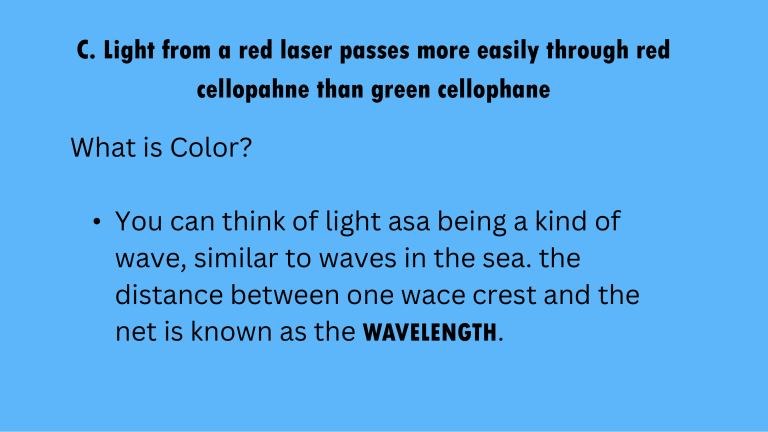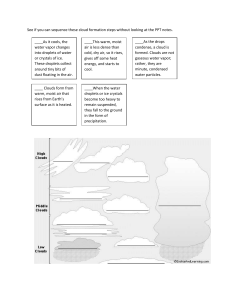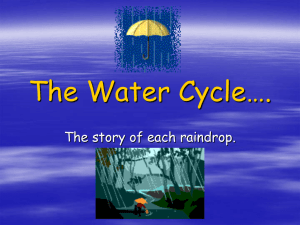
C. Light from a red laser passes more easily through red cellopahne than green cellophane What is Color? • You can think of light asa being a kind of wave, similar to waves in the sea. the distance between one wace crest and the net is known as the WAVELENGTH. DIFFERENT colors have different wavelengths The wavelength of RED LIGHT is just under one 5000 of an inch, while violet light just over on 1 0,000 of an inch. All the other colors fall somewhere between these two extremes. Sunlight or the light an electric bulb seems colorless, we cll it “white light”. But in fact it contains the full range or SPECTRUM of colors from RED through orange, yellow, green, blue and indigo to violet. When these color pass from air to water or glass, they are slowed down and refracted by different amounts. RED LIGHT is bent the least, violet light are the most. A FILTER is a material such as colored cellophanes or glass, that only lets light of particular color pass though. This means that a red object appear bright when seen through a red filter but an object of another color seems dark • If you look through a green cellophane, everything on the other side appears to be shades of green. • If you look through a red glass, everything appears to be red. • • Green cellophane will only allow green light to pass through it, the cellophane absorbs other color of light. As a general rule, each color filter will only allow light of its own colour to pass through. D. Clothing of certain colors appear different in artificial light and in sunlight Sunlight and fluorescent (artificial) light both appear as “white light,” they each contain slightly different mixtures of these varying wavelengths. When sunlight and fluorescent light (white light) are absorbed by a piece of clothing, only some of the wavelengths (composing white light) reflect off the clothing. Light is made up of wavelengths of light, and each wavelength is a particular colour. The colour we see is a result of which wavelengths are reflected back to our eyes. • White light is actually made of all of the colours of the rainbow because it contains all wavelengths, and it is described as polychromatic light. • Objects appear different colours because they absorb some colours (wavelengths) and reflect or transmit other colours. The colours we see are the wavelengths that are reflected or transmitted. For example, a red shirt looks red because the dye molecules in the fabric have absorbed the wavelengths of light from the violet/blue end of the spectrum. Red light is the only light that is reflected from the shirt. If only blue light is shone onto a red shirt, the shirt would appear black, because the blue would be absorbed and there would be no red light to be reflected. White objects appear white because they reflect all colours. Black objects absorb all colours so no light is reflected. CRI stands for color rendering index. CRI measures and compares (on a scale of 0 to 1 00) the ability of a light source to accurately reproduce the color of an object under artificial light. An LED bulb that perfectly replicates the sun has a CRI of 1 00, allowing objects to appear clearly, and naturally, and colors to appear truer across a wide spectrum. Surprisingly, halogen and incandescent bulbs, despite their awful energy efficiency, produce a full, natural and excellent light spectrum with a CRI of 1 00. We all know every light source is not the same. An object may reflect slightly different shades of color under different artificial lights like LED lighting, incandescent bulbs, and fluorescent and halogen light sources. In simple terms, the closer the light source is to natural daylight, the more accurate the color rendering you see on the object. A red dress under a fluorescent light may not seem as radiant as it will in natural sunlight. The following illustration will help you understand how the color rendering capability of an artificial light source affects what we see as a result. The color appearance of an object under consideration significantly deteriorates under a low CRI LED bulb. E. Haloes, sundogs, primary rainbows, secondary rainbows, and supernumerary bows. Haloes Haloes are coloured or white rings or arcs in the sky usually near the moon or sun. (Have you ever wondered why there is a white arc formed around the moon or sun? These are called haloes. Haloes are coloured or white rings or arcs in the sky usually near the moon or sun when the temperature in the atmosphere is low.) Formed due to either refraction and dispersion or reflection of light as it enters hexagonal ice crystals suspended in the clouds. • Refraction and Dispersion: As light enters the ice crystal, it is refracted. • As it leaves the crystal, it is once again refracted at 22° and dispersed into different colors. • In this case, the arcs or rings are composed of different colors. Reflection: Instead of being refracted, the light is reflected at 22 °. In this case, the ring is just white. Haloes Circular arcs are formed when light strikes the ice crystal at different angles, taking all the possible orientation. Sundogs Spots of colors beside the sun or moon. • Formed due to refraction of light as it enters the hexagonal ice crystal. • The collective refracted lights at 22 ° formed sundogs. Primary Rainbow Rainbow is a result of reflection, refraction, and dispersion of white light as it encounters a water droplet. • As white light strikes water droplet, some is reflected. • Some is refracted as the light enters the front surface of the droplet. • Inside the droplet, the white light is dispersed into several colors. • As the light reaches the other side of the drop, the light is reflected towards one side of the droplet. • The light is once again refracted as it moves from the droplet to air. Secondary Rainbow • Secondary rainbow is fainter and larger than a primary rainbow with colors in reverse order. • Result of two refractions, two reflections and dispersion of light. • As light enters into the water droplet, it is refracted. • Inside the water droplet, the white light is dispersed its component colors. • From point a, the light will then be reflected towards point b. • From point b, the light will be reflected again towards point c. • Finally, as the light exits the water droplet, it is refracted once again. Supernumerary Bows • Extra bands inside a primary rainbow. • Results of interference of light from water droplets of the same size. • During interference, light waves which are misaligned, cancel each other out. • Light waves aligned with other combinations of waves, forming the additional bands. Summary: • Haloes - Colored arcs: Refraction and Diffraction White Arc: Reflection • Sundogs - Refraction of light • Primary Rainbow - Refraction, Reflection, Dispersion • Secondary Rainbow - Two refractions, Two reflections, dispersion • Supernumerary Bows - Interference F. Why clouds are usually white and rainclouds dark What causes clouds? A cloud is defined as 'a visible aggregate of minute droplets of water or particles of ice or a mixture of both floating in the free air'. Each droplet has a diameter of about a hundredth of a millimeter and each cubic meter of air will contain 1 00 million droplets. Because the droplets are so small, they can remain in liquid form in temperatures of -30 °C. If so, they are called supercooled droplets. Cloud formation: Clouds form when the invisible water vapor in the air condenses into visible water droplets or ice crystals. For this to happen, the parcel of air must be saturated, i.e. unable to hold all the water it contains in vapor form, so it starts to condense into a liquid or solid form. Why are clouds white? Clouds are white because light from the Sun is white. As light passes through a cloud, it interacts with the water droplets, which are much bigger than the atmospheric particles that exist in the sky. When sunlight reaches an atmospheric particle in the sky, blue light is scattered away more strongly than other colours, giving the impression that the sky is blue. But in a cloud, sunlight is scattered by much larger water droplets. These scatter all colours almost equally meaning that the sunlight continues to remain white and so making the clouds appear white against the background of the blue sky. So why are clouds sometimes grey? Cloud bases are often grey as a result of the same scattering that makes them white. When light is scattered in a cloud it usually is sent back upwards, or out to the sides of the cloud, making the tops and sides of the cloud whiter than the base which receives less light. This is more prominent in rain clouds because the cloud droplets are bigger, thus scattering more light. This means that even less light from the Sun reaches the bottom of the cloud, giving rain clouds their intimidating appearance. Rain clouds are gray instead of white because of their thickness, or height. That is, a cloud gets thicker and denser as it gathers more water droplets and ice crystals — the thicker it gets, the more light it scatters, resulting in less light penetrating all the way through it. References: https://www.sciencelearn.org.nz/resources/47 -colours-of-light https://energyperformancelighting.com/whats-cri/ https://rclite.com/blog/color-rendering-index/ https://www.weather.gov/source/zhu/ZHU_Training_Page/clouds/cloud_development/clouds.htm https://www.livescience.com/39069-why-are-rain-clouds-dark.html https://www.scribd.com/presentation/534485099/WHY-LIGHT-FROM-THE-RED-LASER-PASING-EASILY-THROUGH-RED-CELLOPHANE-THANGREEN





